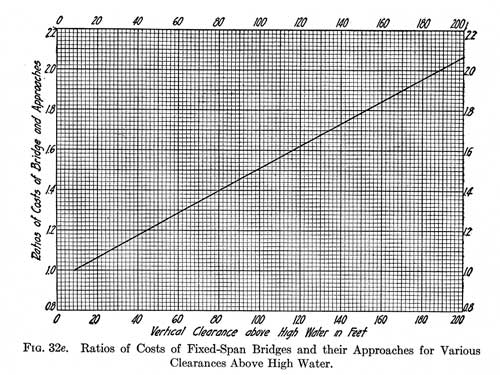| POSSIBILITIES AND ECONOMICS OF THE TRANSBORDEUR | 331 |
|
for the crossing at that place, when the pier-locations and span-lengths are constant, the ratios of costs of fixed-span bridges and their approaches forall clearances above high water up to 200 feet, using as the comparing unit the cost of the bridge having a clearance of only ten feet, which is as small as generally is permissible. Curiously enough, the costs of the three bridges specially figured for the diagram make the record a straight line. The cost of the transbordeur with short cages in this case is almost equal to that for a fixed-span bridge having a clearance of ten feet, as given by the diagram; and that for a clearance of 60 feet is shown to be 1.28 times that for the lowest structure and, therefore, also 1.28 times that for the transbordeur. In view of the comparatively small difference in cost between
transbordeur and fixed-span bridge, and of the facts that a climb of 65 feet above the water is by no means prohibitory for any class of vehicle, even the horse-drawn,—that the carrying capacity of the bridge is generally greater than that of the transbordeur for both pedestrians and street-cars and always much greater for automobiles,—and that horse-drawn vehicles are fast becoming obsolete,—the deduction can be made that, for crossings with moderately-high vertical-clearance, the fixed-span bridge is decidedly preferable to the transbordeur. It is true that this general inference has been drawn from a single case, and on that account may not be satisfactory to some engineers; but the author is of the opinion that, were similar reasoning applied to any other practical case, a like conclusion would be reached. |
